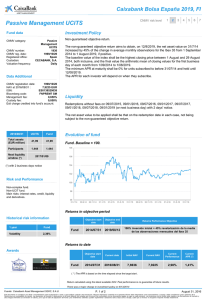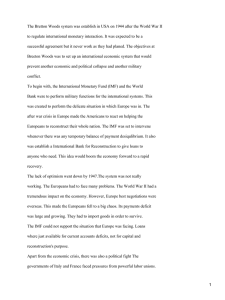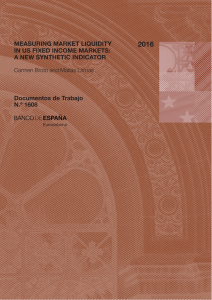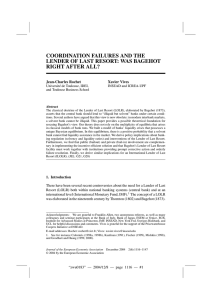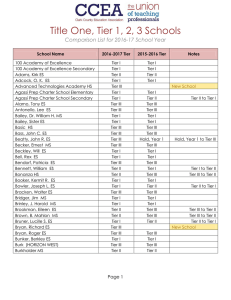English - Banco de Chile
Anuncio
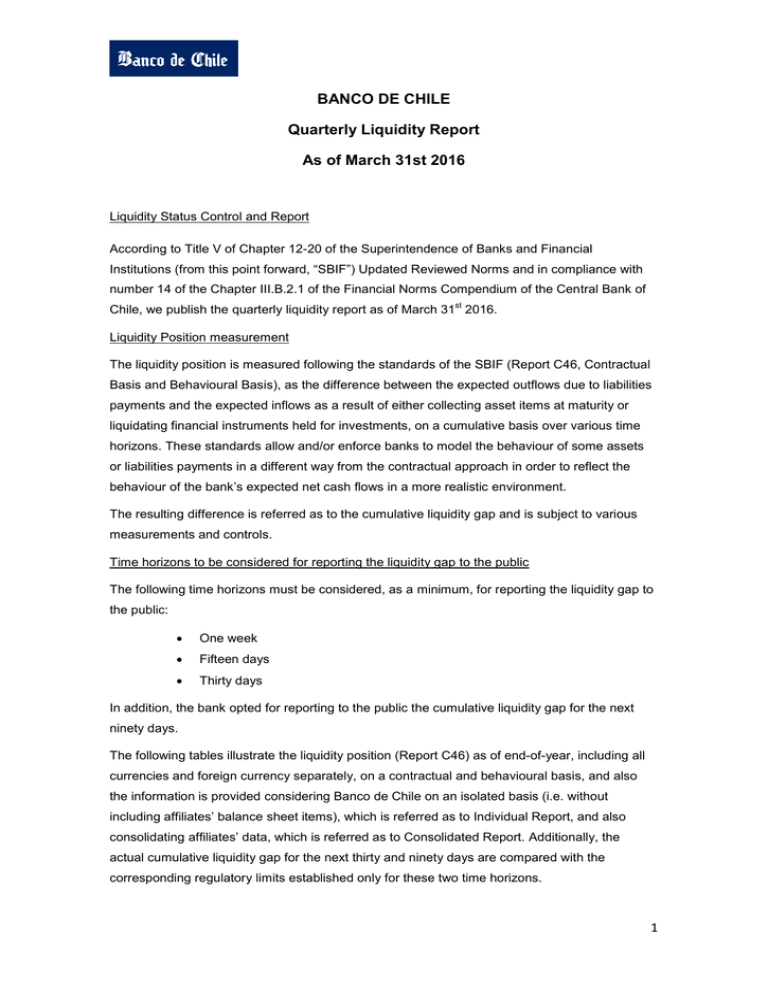
BANCO DE CHILE Quarterly Liquidity Report As of March 31st 2016 Liquidity Status Control and Report According to Title V of Chapter 12-20 of the Superintendence of Banks and Financial Institutions (from this point forward, “SBIF”) Updated Reviewed Norms and in compliance with number 14 of the Chapter III.B.2.1 of the Financial Norms Compendium of the Central Bank of st Chile, we publish the quarterly liquidity report as of March 31 2016. Liquidity Position measurement The liquidity position is measured following the standards of the SBIF (Report C46, Contractual Basis and Behavioural Basis), as the difference between the expected outflows due to liabilities payments and the expected inflows as a result of either collecting asset items at maturity or liquidating financial instruments held for investments, on a cumulative basis over various time horizons. These standards allow and/or enforce banks to model the behaviour of some assets or liabilities payments in a different way from the contractual approach in order to reflect the behaviour of the bank’s expected net cash flows in a more realistic environment. The resulting difference is referred as to the cumulative liquidity gap and is subject to various measurements and controls. Time horizons to be considered for reporting the liquidity gap to the public The following time horizons must be considered, as a minimum, for reporting the liquidity gap to the public: One week Fifteen days Thirty days In addition, the bank opted for reporting to the public the cumulative liquidity gap for the next ninety days. The following tables illustrate the liquidity position (Report C46) as of end-of-year, including all currencies and foreign currency separately, on a contractual and behavioural basis, and also the information is provided considering Banco de Chile on an isolated basis (i.e. without including affiliates’ balance sheet items), which is referred as to Individual Report, and also consolidating affiliates’ data, which is referred as to Consolidated Report. Additionally, the actual cumulative liquidity gap for the next thirty and ninety days are compared with the corresponding regulatory limits established only for these two time horizons. 1 INDIVIDUAL QUARTERLY LIQUIDITY REPORT (C46) CONTRACTUAL MATURITY CASHFLOWS BASIS ST AS OF MARCH 31 , 2016 (Amounts in $ MM) ALL CURRENCIES Up to 7 days Up to 15 days Up to 30 days Inflows 4.838.259 5.522.459 6.159.907 Up to 90 days 8.996.223 Outflows 10.083.933 11.365.762 13.684.631 16.790.818 Liquidity Gap 5.245.674 5.843.303 7.524.724 7.794.595 Regulatory limits: 2.760.994 1 x Tier 1 Capital 2 x Tier 1 Capital 5.521.988 LIQUIDITY SURPLUS/(DEFICIT) FOREIGN CURRENCY (4.763.730) (2.272.607) Up to 7 days Up to 15 days Up to 30 days Up to 90 days 630.603 841.978 930.827 1.837.042 Outflows 1.729.052 1.883.394 2.166.151 2.978.216 Liquidity Gap 1.098.449 1.041.416 1.235.324 1.141.174 Inflows Regulatory limits: 1 x Tier 1 Capital 2.760.994 LIQUIDITY SURPLUS/(DEFICIT) 1.525.670 N/A INDIVIDUAL QUARTERLY LIQUIDITY REPORT (C46) BEHAVIOURAL MATURITY CASHFLOWS BASIS AS OF MARCH 31ST, 2016 (Amounts in $ MM) ALL CURRENCIES Up to 7 days Up to 15 days Up to 30 days Up to 90 days Inflows 4.672.846 5.130.827 5.471.336 7.203.595 Outflows 5.213.635 5.883.432 7.108.359 9.522.001 540.789 752.605 1.637.023 2.318.406 Liquidity Gap Regulatory limits: 2.760.994 1 x Tier 1 Capital 2 x Tier 1 Capital 5.521.988 LIQUIDITY SURPLUS/(DEFICIT) FOREIGN CURRENCY Inflows Outflows Liquidity Gap 1.123.971 3.203.582 Up to 7 days Up to 15 days Up to 30 days Up to 90 days 595.534 761.357 769.377 1.214.885 1.143.179 1.254.368 1.471.974 2.230.441 547.645 493.011 702.597 1.015.556 Regulatory limits: 1 x Tier 1 Capital 2.760.994 LIQUIDITY SURPLUS/(DEFICIT) 2.058.397 N/A 2 CONSOLIDATED QUARTERLY LIQUIDITY REPORT (C46) CONTRACTUAL MATURITY CASHFLOWS BASIS ST AS OF MARCH 31 , 2016 (Amounts in $ MM) ALL CURRENCIES Up to 7 days Up to 15 days Up to 30 days Up to 90 days Inflows 5.231.426 5.951.552 6.620.360 9.475.104 Outflows 10.400.901 11.717.101 14.088.162 17.201.469 Liquidity Gap 5.169.475 5.765.549 7.467.802 7.726.365 Regulatory limits: 2.760.994 1 x Tier 1 Capital 2 x Tier 1 Capital 5.521.988 LIQUIDITY SURPLUS/(DEFICIT) FOREIGN CURRENCY Up to 7 days Inflows Up to 15 days (4.706.808) (2.204.377) Up to 30 days Up to 90 days 652.817 863.525 952.374 1.857.254 Outflows 1.750.610 1.904.952 2.187.849 2.999.915 Liquidity Gap 1.097.793 1.041.427 1.235.475 1.142.661 Regulatory limits: 1 x Tier 1 Capital 2.760.994 LIQUIDITY SURPLUS/(DEFICIT) 1.525.519 N/A CONSOLIDATED QUARTERLY LIQUIDITY REPORT (C46) BEHAVOURIAL MATURITY CASHFLOWS BASIS ST AS OF MARCH 31 , 2016 (Amounts in $ MM) ALL CURRENCIES Up to 7 days Up to 15 days Up to 30 days Up to 90 days Inflows 5.066.013 5.559.921 5.931.789 7.682.476 Outflows 5.530.602 6.234.771 7.511.891 9.932.652 464.589 674.850 1.580.102 2.250.176 Liquidity Gap Regulatory limits: 2.760.994 1 x Tier 1 Capital 2 x Tier 1 Capital 5.521.988 LIQUIDITY SURPLUS/(DEFICIT) FOREIGN CURRENCY Inflows Outflows Liquidity Gap 1.180.892 3.271.812 Up to 7 days Up to 15 days Up to 30 days Up to 90 days 617.749 782.904 790.924 1.235.098 1.164.738 1.275.927 1.493.673 2.252.139 546.989 493.023 702.749 1.017.041 Regulatory limits: 1 x Tier 1 Capital 2.760.994 LIQUIDITY SURPLUS/(DEFICIT) 2.058.245 N/A 3 LIQUID ASSETS CONSOLIDATED BALANCE SHEET ST AS OF MARCH 31 , 2016 Amounts in $ MMM Cash and Due 2.008 Investments marked at market prices 2.186 MAIN FUNDING SOURCES CONSOLIDATED BALANCE SHEET ST AS OF MARCH 31 , 2016 Amounts in $ MMM Demand deposits accounts 2.593 Savings accounts and time deposits 5.958 7.857 1.207 Borrowings from financial institutions Debt issued 10.731 Others 4 Main aspects of the Liquidity Management Process In accordance with the Title V of the Chapter 12-20 of the SBIF Updated Reviewed Norms, “Information to the Public”, following are summarized the main aspects of Banco de Chile’s liquidity management process. Liquidity Risk definition Liquidity risk is the risk that the firm will not be able to obtain the funds when they are required to efficiently meet its payments obligations without adversely impacting the financial condition of the firm. Liquidity Risk Management main targets a. To ensure that funds are always available to meet both expected and unexpected current and future cash flow needs, being also in compliance with all regulatory liquidity requirements. b. To ensure that funding capacity may be always available to take advantage of business opportunities. c. To ensure that the firm is able to liquidate price risk positions without materially altering market prices, attracting the attention of other market participants or compromising on counterparty quality. Organization structure: roles and responsibilities The Treasury/Sales & Trading unit is responsible of the liquidity management of the bank, with the support and oversight of the Risk Management unit through the Market Risk Management area. Independent areas of the Financial Control unit are in charge of measuring and reporting market risks metrics. The ALCO (Assets & Liabilities Committee) on a monthly basis is thoroughly informed about the evolution of different metrics related with price and liquidity risks; the board is informed on a quarterly basis about market risks, including stress tests and derivatives credit risk exposures. Liquidity Risk Management Governance The liquidity management process is governed by the guidelines stated in the Liquidity Risk Management Policy, which is approved by the board and reviewed at least annually. The board, according to the Liquidity Risk Management Policy, defines the liquidity risk appetite by establishing internal limits in addition to those established by the regulators. Additionally, internal triggers are defined to control various financial ratios; payment dates concentrations, payments concentration by counterparts, products, etc. are also under oversight through triggers. Finally, market triggers are also established in order to early detect changes on the liquidity market conditions. The reporting and limits/triggers controlling processes are daily executed by independent areas. Additionally, the Liquidity Risk Management Policy establish the escalation process when limits 5 breach or triggers activation occur; limit exceptions or permanent limits/triggers changes, previous to the regular annual review, are also duly addressed in the policy. 6
